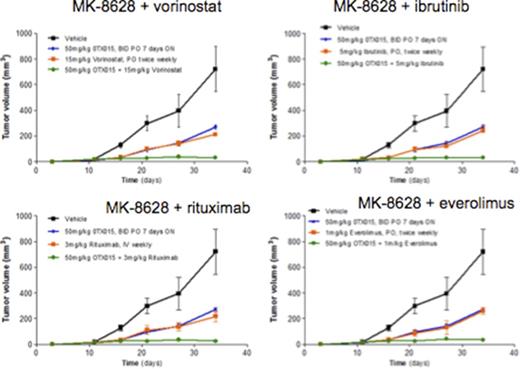Abstract
OTX015 (MK-8628) has shown anti-lymphoma activity in both the preclinical and clinical settings (Boi et al, CCR 2015; Stathis et al, EORT-NCI-AACR 2014). Here we report in vivo data on OTX015 in combination with four targeted compounds in DLBCL.
Methods. NOD-Scid (NOD.CB17-Prkdcscid/NCrHsd) mice were subcutaneously engrafted with the activated B-cell like DLBCL cell line SUDHL2 (15 x106 cells) and then divided into 10 groups (6 mice each). Treatment with OTX015 was started 3 days after the graft, and treatments with other drugs were initiated when mice developed palpable tumors (100 mm3). Tumor size was measured two times per week using digital calipers. Tumor volumes were calculated using the equation V = [length x width2]/2 (width and length are the shortest and the longest diameters of each tumor, respectively). Tumor specimens were collected at the end of treatment and necrosis was semi-quantitatively defined on the total amount of neoplastic tissue.
Results. Xenografts of SU-DHL-2 were treated with control or OTX015 (50 mg/kg once daily; QDx7/w x5w), the BTK-inhibitor ibrutinib (5 mg/kg; QDx2/w x5w), the mTOR-inhibitor everolimus (1 mg/kg, Qdx2/w x5w), the HDAC-inhibitor vorinostat (15 mg/kg; QDx2/w x5w), the anti-CD20 monoclonal antibody rituximab (3 mg/kg; QDx1/w x5w) as single agents or in OTX015-containing combinations. No weight loss was reported. OTX015, in accordance previously published data (Boi et al, CCR 2015), as single agent delayed tumor growth. Almost complete eradication of tumors was observed in mice treated with OTX015 combinations (p<0.001) (Figure 1). Three tumors for each group were H&E stained and necrosis percentage evaluated. Only control and vorinostat-treated tumors showed no or minimal (<5%) necrosis, which appeared higher in tumors treated with all the other drugs as single agents and in the combinations.
Conclusions. OTX015-containing combinations with everolimus, ibrutinib, vorinostat and rituximab showed very promising in vivo activity in an ABC-DLBCL model, providing the rationale for future clinical studies.
In vivo treatment of ABC-DLBCL SU-DHL-2 xenografts with MK-8228 as single agent and in combination with other targeted drugs.
In vivo treatment of ABC-DLBCL SU-DHL-2 xenografts with MK-8228 as single agent and in combination with other targeted drugs.
Riveiro:Oncology Therapeutic Development: Employment. Cvitkovic:Oncology Therapeutic Development: Employment, Membership on an entity's Board of Directors or advisory committees. Bertoni:PIQUR Therapeutics AG: Research Funding; Oncology Therapeutic Development: Research Funding.
Author notes
Asterisk with author names denotes non-ASH members.


This feature is available to Subscribers Only
Sign In or Create an Account Close Modal